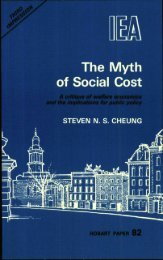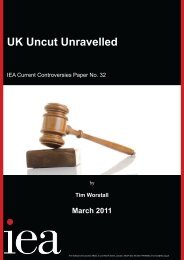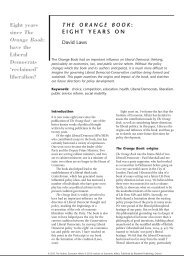… and the Pursuit of Happiness - Institute of Economic Affairs
… and the Pursuit of Happiness - Institute of Economic Affairs
… and the Pursuit of Happiness - Institute of Economic Affairs
You also want an ePaper? Increase the reach of your titles
YUMPU automatically turns print PDFs into web optimized ePapers that Google loves.
<strong>…</strong> <strong>and</strong> <strong>the</strong> pursuit <strong>of</strong> happiness<br />
subjective wellbeing<br />
zero, <strong>and</strong> we cannot reject our conclusion that <strong>the</strong>se coefficients<br />
lie between 0.3 <strong>and</strong> 0.4. Indeed, if anything, <strong>the</strong> World Values<br />
Survey yields estimates <strong>of</strong> <strong>the</strong> satisfaction–income gradient<br />
that are somewhat larger. The critique levelled by Easterlin <strong>and</strong><br />
Sawangfa seems, quite simply, wrong.<br />
Figure 6 provides fur<strong>the</strong>r evidence <strong>of</strong> why estimating <strong>the</strong><br />
relationship between subjective wellbeing <strong>and</strong> long-run growth<br />
has challenged researchers. There are many countries which do<br />
not fit <strong>the</strong> general trend that growth in satisfaction is correlated<br />
with GDP growth. Bulgaria, Ukraine, Venezuela <strong>and</strong> Estonia all<br />
experienced considerable declines in income, with no accompanying<br />
decline in wellbeing. Fur<strong>the</strong>rmore, a researcher, worried<br />
about outliers, could easily drop a h<strong>and</strong>ful <strong>of</strong> influential countries<br />
from <strong>the</strong> sample – such as Russia, Hungary, Slovenia <strong>and</strong> Korea.<br />
Doing so clearly does not eliminate <strong>the</strong> positive correlation, but it<br />
does substantially reduce <strong>the</strong> statistical power <strong>of</strong> <strong>the</strong> regression,<br />
because <strong>the</strong>se extreme cases involve so much <strong>of</strong> <strong>the</strong> variation in<br />
GDP. When we exclude <strong>the</strong>se countries from our regression <strong>of</strong><br />
long-run differences, our estimate <strong>of</strong> <strong>the</strong> relationship between<br />
satisfaction <strong>and</strong> GDP growth remains positive <strong>and</strong> comparable<br />
with o<strong>the</strong>r estimates at 0.26, but <strong>the</strong> st<strong>and</strong>ard error grows to 0.15.<br />
Figure 7<br />
Change in satisfaction, relative to country <strong>and</strong> wave fixed effects<br />
.4<br />
.2<br />
0<br />
–.2<br />
–.4<br />
Decadal differences in life satisfaction <strong>and</strong> log GDP:<br />
Eurobarometer<br />
FRA 07-97<br />
LUX 87-77<br />
DNK 97-87<br />
GBR 87-77<br />
–.2<br />
ITA 07-97<br />
BEL 07-97<br />
FRG 07-97<br />
GRC 97-87<br />
ITA 97-87<br />
NLD 07-97<br />
GRC 07-97<br />
ESP 07-97<br />
FRG 87-77 PRT 97-87<br />
ITA 87-77<br />
FIN 07-97<br />
FRA 87-77<br />
ESP 97-87<br />
BEL 87-77<br />
IRL 87-77<br />
NOR 97-87<br />
IRL 97-87<br />
LUX 07-97<br />
GDR 07-97<br />
LUX 97-87<br />
GDR 97-87<br />
IRL 07-97<br />
y = 0.01+0.28*ln(x) [se=0.16]<br />
Correlation=0.19<br />
0 .2 .4<br />
Change in log GDP, relative to country <strong>and</strong> wave fixed effects<br />
Note 1: The dashed line gives <strong>the</strong> ordinary least squares (OLS) fit <strong>and</strong> <strong>the</strong> dotted line is fitted from<br />
lowess regression. Selected countries only have been marked.<br />
Note 2: The figures ‘87’, ‘97’ etc. denote <strong>the</strong> mid points <strong>of</strong> <strong>the</strong> two decades for which differences<br />
are taken.<br />
Results using <strong>the</strong> Eurobarometer data<br />
This exercise was also repeated using <strong>the</strong> Eurobarometer data.<br />
The advantage <strong>of</strong> <strong>the</strong>se data is that we have many observations<br />
for each country which we can combine to reduce <strong>the</strong> influence <strong>of</strong><br />
measurement error. Thus we construct long-run differences in <strong>the</strong><br />
Eurobarometer by taking averages <strong>of</strong> satisfaction <strong>and</strong> log GDP for<br />
each country in each <strong>of</strong> <strong>the</strong> decades 1973–82, 1983–92, 1993–2002<br />
<strong>and</strong> 2003–07. We <strong>the</strong>n construct decadal differences in satisfaction<br />
<strong>and</strong> GDP by comparing adjacent decades <strong>and</strong> plot <strong>the</strong>se<br />
decadal differences in Figure 7; we report <strong>the</strong> regression estimates<br />
in Table 1, column 4. Each point represents a single decadal difference<br />
in satisfaction <strong>and</strong> GDP for a given country. Many countries<br />
experienced sluggish income growth but no relative slowdown<br />
in subjective wellbeing: most <strong>of</strong> <strong>the</strong>se countries are in western<br />
82 83












